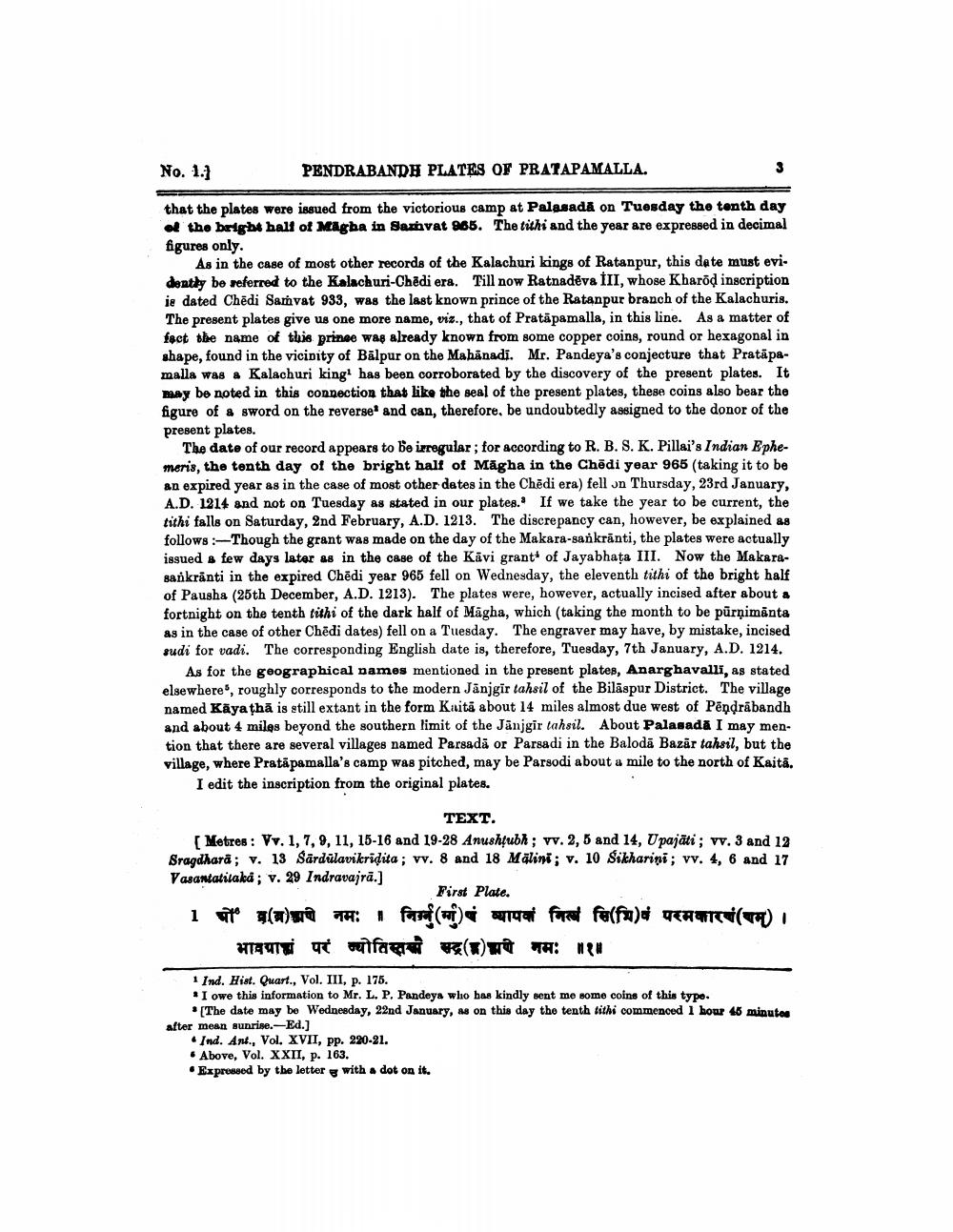________________
No. 1.
PENDRABANDH PLATES OF PRATAPAMALLA.
that the plates were issued from the victorious camp at Palasada on Tuesday the tenth day of the bright hall of Magba in Sazovat 865. The tithi and the year are expressed in decimal figures only.
As in the case of most other records of the Kalachuri kings of Ratanpur, this date must evi. dently be referred to the Kalachuri-Chēdi era. Till now Ratnadēva III, whose Kharod inscription is dated Chēdi Samvat 933, was the last known prince of the Ratanpur branch of the Kalachuris. The present plates give us one more name, viz., that of Pratäpamalla, in this line. As a matter of fact the name of this prince was already known from some copper coins, round or hexagonal in shape, found in the vicinity of Bālpur on the Mahanadi. Mr. Pandeya's conjecture that Pratāpamalla was a Kalachuri king' has been corroborated by the discovery of the present plates. It may be noted in this connection that like the seal of the present plates, these coins also bear the figure of & sword on the reverse and can, therefore, be undoubtedly assigned to the donor of the present plates.
The date of our record appears to be irregular, for according to R. B. S. K. Pillai's Indian Ephemeris, the tenth day of the bright half of Māgha in the Chēdi year 965 (taking it to be an expired year as in the case of most other dates in the Chēdi era) fell on Thursday, 23rd January, A.D. 1214 and not on Tuesday as stated in our plates. If we take the year to be current, the tithi falls on Saturday, 2nd February, A.D. 1213. The discrepancy can, however, be explained as follows: Though the grant was made on the day of the Makara-sankranti, the plates were actually issued a few days later as in the case of the Kāvi grant of Jayabhata III. Now the Makarasankranti in the expired Chedi year 965 fell on Wednesday, the eleventh tithi of the bright half of Pausha (25th December, A.D. 1213). The plates were, however, actually incised after about a fortnight on the tenth tithi of the dark half of Māgha, which taking the month to be purnimanta as in the case of other Chēdi dates) fell on a Tuesday. The engraver may have, by mistake, incised sudi for vadi. The corresponding English date is, therefore, Tuesday, 7th January, A.D. 1214.
As for the geographical names mentioned in the present plates, Anarghavalli, as stated elsewhere, roughly corresponds to the modern Janjgir tahsil of the Bilaspur District. The village named Kāyathā is still extant in the form Kaita about 14 miles almost due west of Pēndrábandh and about 4 miles beyond the southern limit of the Janjgir tahsil. About Palasada I may mention that there are several villages named Parsadā or Parsadi in the Balodā Bazar tahsil, but the village, where Pratápamalla's camp was pitched, may be Parsodi about a mile to the north of Kaita.
I edit the inscription from the original plates.
TEXT. Metres: Vv. 1, 7, 9, 11, 15-16 and 19-28 Anushțubh; vv. 2, 5 and 14, Upajäti; vv. 3 and 12 Sragdhara; v. 13 Särdülavikridita; vv. 8 and 18 Mälini; v. 10 Sikharini; vv. 4, 6 and 17 Vasantatilakd ; v. 29 Indravajra.)
First Plate. i ato (a) : forf () -142 faren farfu). TAUTE( )
भावयाचं पर ज्योतिस्वी मद्र(मणे नमः ॥१॥
1 Ind. Hist. Quart., Vol. III, p. 175.
I owe this information to Mr. L. P. Pandeya who has kindly sent me some coins of this typo.
* The date may be Wednesday, 22nd January, as on this day the tenth tithi commenced 1 hour 45 minutes after mesn sunrise. -Ed.)
• Ind. Ant., Vol. XVII, pp. 220-21. . Above, Vol. XXII, p. 163. • Expressed by the letter with a dot on it.




